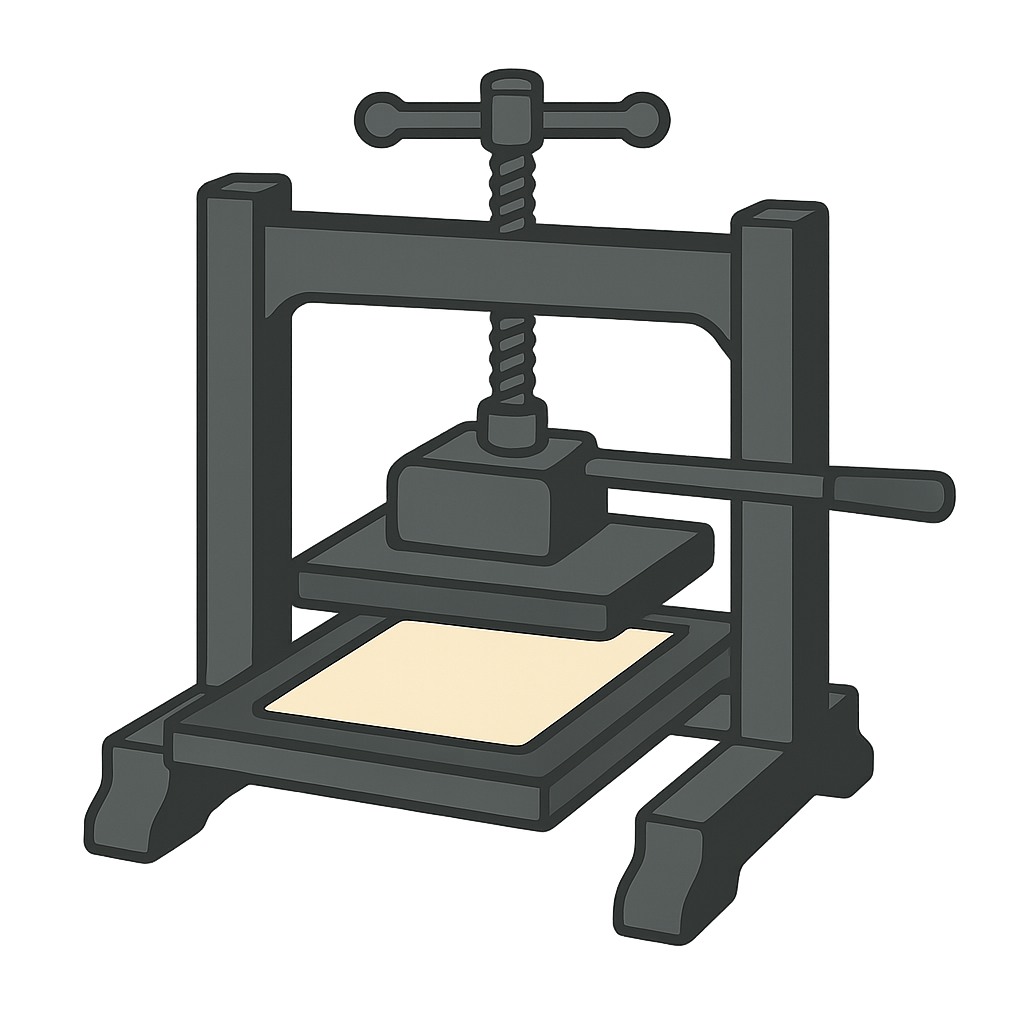I Am the Printing Press: The Machine That Gave Words Wings
Before I Could Speak
Before I had a voice, the world was a much quieter place. Of course, I am not a person; I am a machine, a creature of wood, metal, and ink. You know me as the Printing Press. But in the time before my birth, the world of ideas was hushed, almost silent. Imagine a library where every single book was a precious, one-of-a-kind jewel. Each letter, each word, each beautifully decorated page was painstakingly copied by hand. A single book could take a dedicated scribe months, or even years, to complete. They would hunch over desks in quiet rooms called scriptoriums, their hands cramping as they meticulously duplicated texts, one character at a time. Because of this immense effort, books were incredibly rare and staggeringly expensive. Only the wealthiest nobles, kings, and powerful church leaders could afford them. Knowledge wasn't for everyone; it was a luxury, a treasure locked away in monasteries and palaces. Ideas traveled at the slow, deliberate pace of a tired monk's hand, and a new discovery made in one city might not be heard of in another for a generation. This was the silent world I was destined to fill with a thundering roar of words.
My Creator's Grand Idea
My story truly begins with my creator, a brilliant man named Johannes Gutenberg. He lived in Mainz, Germany, during the 1400s and was a skilled goldsmith and metalworker. He understood the nature of metals—how to shape them, how to make them strong and precise. Gutenberg looked at the world of books and felt a deep frustration. He saw the slow, laborious process of hand-copying and felt it was a cage for human thought. A great question began to burn in his mind, a question that would change history: "What if we could make letters that could be used over and over again? What if we could assemble words and then print them, not just once, but hundreds of times?" This was the spark of my existence. It was a revolutionary idea. Instead of carving an entire page onto a single block of wood, he imagined creating thousands of tiny, individual letters out of a durable metal alloy. These letters—this movable type—could be arranged to form any page, and then rearranged to form the next. It was a puzzle of infinite possibilities. But the letters were only one part of the challenge. The watery ink used by scribes would just run off the metal type. So, Gutenberg experimented, concocting a new kind of ink, one that was thick, sticky, and oil-based, perfect for clinging to my metal letters. Finally, he needed pressure, a force strong and even enough to press the paper onto the inked type. His genius was in looking at the world around him. He saw the giant screw presses used by local farmers to crush grapes for wine and thought, "I can adapt that!" He engineered a machine that could apply firm, uniform pressure, ensuring every letter made its mark, clear and bold. The workshop echoed with the clank of metal and the groan of the wooden press as he brought me to life around the year 1440. There were years of trial and error, of failed pages and financial worries, but Gutenberg was persistent. He knew he was on the verge of giving humanity a powerful new voice.
The First Great Story and a World of Words
Around the year 1455, after countless experiments, I was ready for my first monumental task: to print the Bible. The Gutenberg Bible, as it came to be known, was a masterpiece of art and engineering. I worked tirelessly, my heavy arms pressing down again and again, creating page after perfect page. What had once taken a scribe years to produce, I could now replicate with astonishing speed. In the time a single copy was painstakingly finished by hand, I could produce hundreds. A whisper of knowledge had turned into a mighty roar that echoed across Europe. Soon, my brothers and sisters—other printing presses built from Gutenberg's design—began appearing in cities far and wide. We were unstoppable. We printed maps for explorers charting new worlds, scientific papers that challenged old beliefs, and poetry that stirred the soul. Knowledge began to spread like wildfire, or perhaps more like seeds carried on the wind, taking root in the minds of scholars, merchants, and ordinary people. This explosion of information helped fuel the incredible period of creativity and discovery known as the Renaissance. I gave a voice to reformers, scientists, and storytellers, allowing their ideas to reach millions. My legacy is not just in the clanking metal and oil-based ink of the past. My spirit lives on in every book on your shelf, every newspaper on the stand, and even in the glowing words on the screen you are reading right now. It all started because one clever person had a grand idea to help words fly free, and I was the machine he built to give them wings.
Reading Comprehension Questions
Click to see answer
